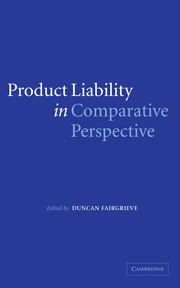Book contents
- Frontmatter
- Contents
- List of figures
- Foreword by Sir Michael Burton
- List of contributors
- Preface
- 1 Introduction
- PART I Country reports
- PART II European influences
- PART III Comparing systems
- 13 Harmonisation or divergence? A comparison of French and English product liability rules
- 14 Product liability law in Central Europe and the true impact of the Product Liability Directive
- 15 Bugs in Anglo-American products liability
- 16 Comparing product safety and liability law in Japan: from Minamata to mad cows – and Mitsubishi
- Appendix
- Index
14 - Product liability law in Central Europe and the true impact of the Product Liability Directive
from PART III - Comparing systems
Published online by Cambridge University Press: 28 July 2009
- Frontmatter
- Contents
- List of figures
- Foreword by Sir Michael Burton
- List of contributors
- Preface
- 1 Introduction
- PART I Country reports
- PART II European influences
- PART III Comparing systems
- 13 Harmonisation or divergence? A comparison of French and English product liability rules
- 14 Product liability law in Central Europe and the true impact of the Product Liability Directive
- 15 Bugs in Anglo-American products liability
- 16 Comparing product safety and liability law in Japan: from Minamata to mad cows – and Mitsubishi
- Appendix
- Index
Summary
Introduction
This study investigates the process of evolution of Central European product liability regimes, with particular attention to the effect of the implementation of the Product Liability Directive in the context of the 2004 Enlargement of the European Union. Central Europe has been chosen as an example of a region which, although remaining under a strong Socialist influence until 1989, has had a long and relatively close relationship with the West. This relationship placed the Central Europeans in a position described by Alan Mayhew as ‘floating dangerously between East and West’. David and Brierley, in 1985, classified the Central European countries, together with Slovenia and Croatia, as the ‘countries of western tradition’ among the Socialist jurisdictions. They pointed out the common historical development of the ‘western tradition’ with Germany, Austria and France – the tradition of Romano-Germanic law. Central European countries seemed to have been too highly developed for a direct implementation of the Communist concepts from Soviet Russia. They were the first nations to break free from the Socialist grip, and the first post-Socialist nations to have concluded Association Agreements with the European Union. The region, so distinct from the West but also so deeply linked to it, is a particularly fertile ground upon which analyses of the post-Socialist transformations can be carried out.
Product liability law, like every other new, specialised discipline of law, has created some confusion within legal science more generally.
- Type
- Chapter
- Information
- Product Liability in Comparative Perspective , pp. 244 - 294Publisher: Cambridge University PressPrint publication year: 2005
- 1
- Cited by



